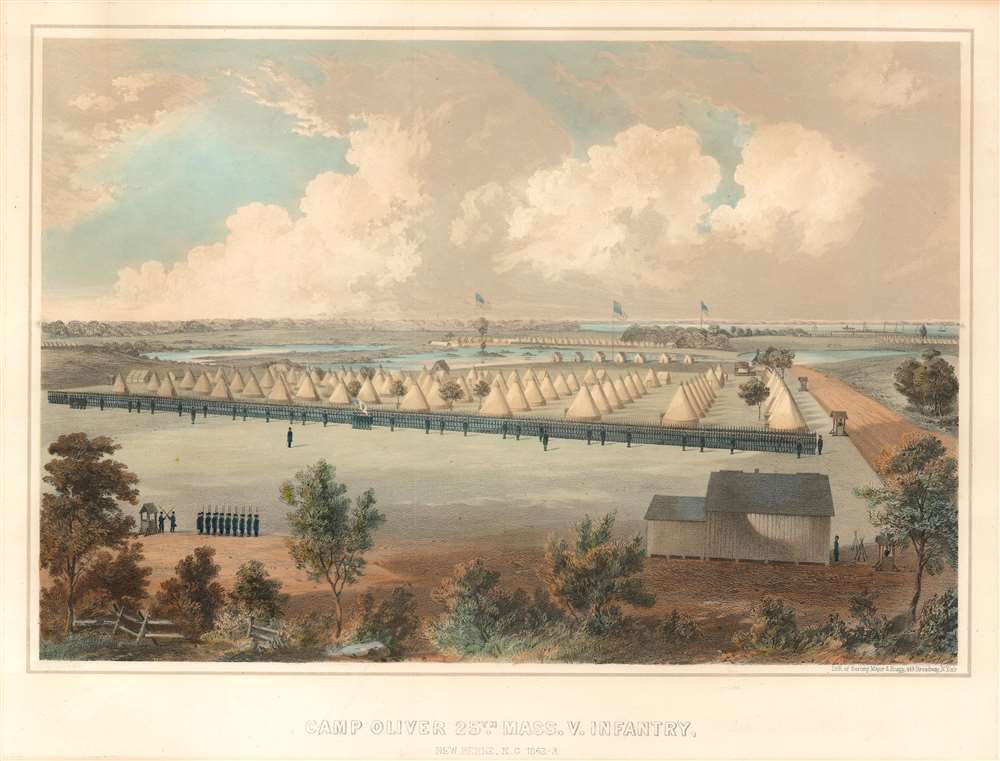This item has been sold, but you can get on the Waitlist to be notified if another example becomes available, or purchase a digital scan.
1863 Sarony, Major, and Knapp View of Camp Oliver, North Carolina
CampOliveNewBern-saronymajorknapp-1863
Title
1863 (dated) 13 x 17 in (33.02 x 43.18 cm)
Description
Census and Publication History
This view was drawn by Voltaire Combe and published by Sarony, Major, and Knapp in 1863. This view is very rare. We have been able to identify only one example in an institutional collection and are aware of one other example in private hands.CartographerS
Napoleon Sarony (March 9, 1821 - November 9, 1896) was a dashingly handsome Canadian-American lithographer and publisher active in New York in the mid to late 19th century. Sarony was born in Quebec and emigrated to New York City in 1835. He apprenticed under Henry Robinson (fl. 1830/33 - 1850) before working as a lithograph artist for Nathaniel Currier (1813 - 1888). In 1846, he partnered with Currier's apprentice lithographer Henry B. Major to establish the firm of 'Sarony and Major.' From offices at 117 Futon Street, they published under this imprint until roughly 1853, when Sarony split off on his own under the imprint 'Sarony and Co.', still at 117 Fulton. At the time 'and Co.' probably meant Joseph Fairchild Knapp (1832 - 1891), Sarony's apprentice, and Richard C. Major, possibly Henry Major's son. In 1857, a new imprint was established as 'Sarony, Major and Knapp'. According to an advertisement in the New York Times (Feb 16, 1864), Sarony had invested in the business at founding, but was not an active partner, possibly because he was traveling in Europe. It is unclear why Sarony's name was maintained, possibly to capitalize on his fame, as a honorific, or possibly because he owned a major stake. They published under this imprint until 1863, becoming a major concern at 449 Broadway. Sarony's name was formally removed from the partnership in 1863. At the time he was traveling in Europe, mastering the most advanced color lithography and photographic techniques. He is known to have worked in France, Germany, and England. He returned to New York in the 1860s, establishing a photography company at 37 Union Square that became famous for its portraits of late-19th-century American theater icons. In 1891, Sarony, hoping to capitalize on Sarah Bernhardt's fame as 'Cleopatra', paid the stage actress 1,500 USD to sit for a photo session, the modern-day equivalent of 20,000 USD - suggesting a highly prosperous business. His son, Otto Sarony (1850–1903), continued the family business as a theater and film star photographer. As an aside, Sarony's second wife, Louie Sarony, was a known eccentric who would reportedly dress in elaborate rented costumes to walk around Washington Square each afternoon. More by this mapmaker...
Joseph Fairchild Knapp (July 1, 1832 - September 14, 1891) was an American printer and publisher active in the second half of the 19th century. From the age of 16, Knapp apprenticed as a lithographer under Napoleon Sarony (1821 - 1896) and Henry B. Major (18?? - 18??), at the firm of 'Sarony and Major.' Henry Major either died or left the firm around 1853, with, possibly, his shares being held in reserve for his son, who was then still an apprentice, Richard C. Major. In 1857, Sarony left the firm to travel and study in Europe, Knapp and Richard Major took over the firm, becoming partners, renaming the business 'Sarony, Major and Knapp' (1857 - 1863). It is unclear why Sarony's name was maintained, possibly to capitalize on his fame, as a honorific, or possibly because he owned a major stake. Nonetheless, in 1863, Sarony, who had been absent for 7 years, was pushed out of the company which was was renamed 'Major and Knapp.' They published under this imprint from various locations over the years: 449 Broadway (1864 - 1866), 71 Broadway (1867 - 1872), and 56 Park Place (1889 - 1892). Richard Major retired in 1888, and the firm was renamed Knapp and Company. The firm grew to become one of the largest lithographic presses in the United States and a major force in American printing. Knapp invested some of his considerable wealth into insurance concerns. In 1868, he was the largest shareholder and director, and chairman of the Metropolitan Insurance Company. He became president of the Metropolitan Insurance Company in 1871, pioneering the idea of the low-cost life insurance policy, propelling MIC to become one of the largest insurers in the United States. All the time, he also continued to operate and manage his printing business, which he passed on to this son Joseph Palmer Knapp (1864 - 1951). Palmer Knapp closed 'Knapp and Company' in 1982, a year after his father's death, to establish the American Lithographic Company, which consolidated various smaller printers under a new imprint. Knapp constructed a large and elegant mansion in Brooklyn, which stood at 554 Bedford Avenue. Learn More...
Richard C. Major (18?? - May 18, 1894) was a New York City and Brooklyn based American lithographer active in the second half of the 19th century. He likely apprenticed under his father Henry B. Major and Napoleon Sarony (1821 - 1896). In 1857, he became a partner in the firm of 'Sarony, Major and Knapp' (1857 - 1863), which from 1863 to 1888 operated as 'Major and Knapp.' In 1888, Richard retired, but in 1891 ran for 'Lithography Commissioner' at the 1891 Buffalo Pan-American Exposition. The 'Major and Knapp' firm was renamed Knapp and Company and operated under Joseph Fairchild Knapp (1832 - 1891) and his son, Joseph Palmer Knapp (1864 - 1951) from 56 Park Place, New York, until 1892. Like his partner, Major was also a major investor and director of the Metropolitan Life Insurance Company. When he died he left a fortune of 280,000 USD, about 10,000,000 USD in modern-day terms. Learn More...

